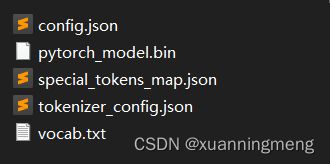transformers中BertPreTrainedModel使用说明
transformers中BertPreTrainedModel使用说明
最近在学习hugging face中的transformers,huggingface中有大量的预训练模型方便使用。有时候使用transformers加载预训练模型做下游任务,保存的模型并不能使用transformers中的api加载,只能使用model.load_state_dict(torch.load())的方式进行加载模型,最近发现transformers中的预训练模型类可以解决上述问题。以BertModel和BertPreTrainedModel为例进行说明。本次代码是一个简单的文本分类。
模型
基于bert预训练模型的文本分类,代码如下:
class ClassifierModel(BertPreTrainedModel):
def __init__(self, config, num_class):
super(ClassifierModel, self).__init__(config)
self.config = config
self.num_class = num_class
self.bert = BertModel(config=self.config)#.from_pretrained(pretrain_model_path)
self.hidden_size = config.hidden_size
self.classifier = nn.Linear(self.hidden_size, self.num_class)
def forward(self, input_ids, token_type_ids, attention_mask, labels=None):
output = self.bert(input_ids=input_ids, token_type_ids=token_type_ids,
attention_mask=attention_mask)[1]
logits = self.classifier(output)
if labels is not None:
entropy_loss = nn.CrossEntropyLoss()
loss = entropy_loss(logits, labels)
return loss, logits
else:
return logits
数据处理过程如下:
class DataProcessor(object):
def __init__(self, data_file, tokenizer, max_seq_len, label2id):
self.data_file = data_file
self.tokenizer = tokenizer
self.max_seq_len = max_seq_len
self.label2id = label2id
self.data = self._read_data()
def _read_data(self):
data = []
with open(self.data_file, "r", encoding="utf-8") as f:
for line in f.readlines():
label, sent = line.strip().split("\t")
data.append({"sent": sent, "label": self.label2id[label]})
random.shuffle(data)
return data
def __len__(self):
return len(self.data)
def __getitem__(self, index):
sent = self.data[index]["sent"]
label = self.data[index]["label"]
features = self.tokenizer(sent, padding=True, truncation=True,
max_length=self.max_seq_len,
add_special_tokens=True)
padding_len = self.max_seq_len - len(features["input_ids"])
input_ids = features["input_ids"] + [self.tokenizer.pad_token_id] * padding_len
token_type_ids = features["token_type_ids"] + [0] * padding_len
attention_mask = features["attention_mask"] + [0] * padding_len
return {"input_ids": input_ids,
"token_type_ids": token_type_ids,
"attention_mask": attention_mask,
"label": label}
def collate_fn(batch_data):
input_ids = [item["input_ids"] for item in batch_data]
token_type_ids = [item["token_type_ids"] for item in batch_data]
attention_mask = [item["attention_mask"] for item in batch_data]
label = [item["label"] for item in batch_data]
input_ids = torch.tensor(input_ids, dtype=torch.long)
token_type_ids = torch.tensor(token_type_ids, dtype=torch.long)
attention_mask = torch.tensor(attention_mask, dtype=torch.long)
label = torch.tensor(label, dtype=torch.long)
return {"input_ids": input_ids, "token_type_ids": token_type_ids,
"attention_mask": attention_mask,
"label": label}
主函数如下:
def main():
pretrain_model_path = "D:/Spyder/pretrain_model/transformers_torch_tf/bert-base-chinese/"
tokenizer = BertTokenizer.from_pretrained(pretrain_model_path)
tokenizer.save_pretrained("./output/")
label2id = {"体育": 0, "健康": 1, "军事": 2}
id2label = {value: key for key, value in label2id.items()}
data_file = "./data/train_data.txt"
batch_size = 2
epochs = 1
lr = 1e-5
max_seq_len = 128
device = "cpu"
train_dataset = DataProcessor(data_file, tokenizer, max_seq_len, label2id)
train_dataloader = DataLoader(train_dataset, batch_size=batch_size,
shuffle=False, collate_fn=collate_fn)
config = BertConfig.from_pretrained(pretrain_model_path,
num_labels=len(label2id),
id2label=id2label,
label2id=label2id
)
model = ClassifierModel.from_pretrained(pretrain_model_path,
config=config,
num_class=3)
model.to(device)
optimizer = AdamW(params=model.parameters(), lr=lr)
for epoch in range(epochs):
model.train()
for step, batch_data in enumerate(train_dataloader):
input_ids = batch_data["input_ids"].to(device)
token_type_ids = batch_data["token_type_ids"].to(device)
attention_mask = batch_data["attention_mask"].to(device)
labels = batch_data["label"].to(device)
loss, _ = model(input_ids, token_type_ids, attention_mask, labels)
optimizer.zero_grad()
loss.backward()
optimizer.step()
print("step:{}, loss:{}".format(step + 1, loss))
model.save_pretrained("./output/")
加载保存模型
这里使用ClassifierModel和BertModel加载保存的模型
model_path = "./output/"
config = BertConfig.from_pretrained(model_path)
model = ClassifierModel.from_pretrained(model_path,
config=config,
num_class=3)
# for parms in model.named_parameters():
# print(parms)
print(model.state_dict().keys())
bert_model = BertModel.from_pretrained("./output/")
print(bert_model.state_dict().keys())
输出模型参数key如下:
bert.embeddings.position_ids ClassifierModel的keys
embeddings.position_ids BertModel的keys
输入一个句子,模型结果如下:
text = "拉齐奥获不利排序意甲本周末拉齐奥与帕尔马之"
tokenizer = BertTokenizer.from_pretrained(model_path)
features = tokenizer(text, padding=True, truncation=True,
max_length=32,
add_special_tokens=True)
input_ids = torch.tensor([features["input_ids"]], dtype=torch.long)
token_type_ids = torch.tensor([features["token_type_ids"]], dtype=torch.long)
attention_mask = torch.tensor([features["attention_mask"]], dtype=torch.long)
bert_output = bert_model(input_ids=input_ids, token_type_ids=token_type_ids,
attention_mask=attention_mask)[1]
print(bert_output.shape)
output = model(input_ids=input_ids, token_type_ids=token_type_ids,
attention_mask=attention_mask)
print(output.shape)
(2)修改模型可以上传到huggingface仓库中
state_dict = torch.load(os.path.join("./output/", "pytorch_model.bin"), map_location=torch.device("cpu"))
new_state_dict = {}
for key, param in state_dict.items():
# Delete "bert" or "roberta" prefix
if "bert." in key:
key = key.replace("bert.", "")
if "roberta." in key:
key = key.replace("roberta.", "")
new_state_dict[key] = param
torch.save(new_state_dict, os.path.join("./output_v2/", "pytorch_model.bin"))
上述是学习huggingface中的transformers的笔记记录,如有疑问,欢迎留言一起交流。
